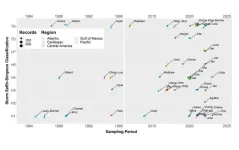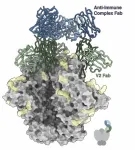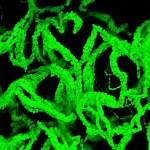(Press-News.org) Polymer editing can upcycle waste into higher-performance plastics
By editing the polymers of discarded plastics, chemists at the Department of Energy’s Oak Ridge National Laboratory have found a way to generate new macromolecules with more valuable properties than those of the starting material. Upcycling may help remedy the roughly 450 million tons of plastic discarded worldwide annually, of which only 9% gets recycled; the rest is incinerated or winds up in landfills, oceans or elsewhere.
ORNL’s invention may change plastic’s environmental fate by rearranging polymeric building blocks to customize the properties of plastics. Molecular subunits link to produce polymer chains that can connect through their backbones and cross-linked molecules to form multipurpose plastics. The makeup of polymer chains determines how strong, rigid or heat-resistant those plastics will be.
Molecular editing is so promising that it has been the basis of two Nobel Prizes in Chemistry. In 2005, the prize went to developers of the metathesis reaction, which breaks and makes double bonds between carbon atoms in rings and chains so their subunits can swap to create new molecules limited only by imagination. Similarly, in 2020, the prize went to developers of CRISPR, “genetic scissors” for editing DNA strands, biopolymers made of nucleotide subunits that carry the code of life.
”This is CRISPR for editing polymers,” said ORNL’s Jeffrey Foster, who led a study that was published in Journal of the American Chemical Society. “However, instead of editing strands of genes, we are editing polymer chains. This isn’t the typical plastic recycling ‘melt and hope for the best’ scenario.”
The ORNL researchers precisely edited commodity polymers that significantly contribute to plastic waste. In some experiments, the researchers worked with soft polybutadiene, which is common in rubber tires. In other experiments, they worked with tough acrylonitrile butadiene styrene, the stuff of plastic toys, computer keyboards, ventilation pipes, protective headgear, vehicle trim and molding, and kitchen appliances.
“This is a waste stream that's really not recycled at all,” Foster said. “We're addressing a significant component of the waste stream with this technology. That'd make a pretty big impact just from conservation of mass and energy from materials that are now going into landfills.”
Dissolving the waste polymers is the first step in creating drop-in additives for polymer synthesis. The researchers shredded synthetic or commercial polybutadiene and acrylonitrile butadiene styrene and immersed the material in a solvent, dichloromethane, to conduct a chemical reaction at a low temperature (40 degrees Celsius) for less than two hours.
A ruthenium catalyst facilitated the polymerization, or polymer addition. Industrial firms have used this catalyst to make robust plastics and to convert biomass such as plant oils into fuels and other high-value organic compounds with no difficulty, highlighting the potential for its use in chemical upcycling.
The molecular building blocks of the polymer backbone contain functional groups, or clusters of atoms that serve as reactive sites for modification. Notably, the double bonds between carbons increase the chances for chemical reactions that enable polymerization. A carbon ring opens at a double bond to create a polymer chain that grows as each functional polymer unit directly slips in, conserving the material. The plastic additive also helps control the molecular weight of the synthesized material and, in turn, its properties and performance.
If this material synthesis strategy could be expanded to a broader range of industrially important polymers, then it could prove an economically viable path for reusing manufacturing materials that today can only be used in a single product. The upcycled materials might be, for instance, softer and stretchier than the original polymers or, perhaps, easier to shape and harden into durable thermoset products.
The scientists upcycled plastic waste by employing two processes in tandem. Both are types of metathesis, which means a change of places. Double bonds break and form between carbon atoms, allowing polymer subunits to swap.
One process, called ring-opening metathesis polymerization, opens carbon rings and elongates them into chains. The other process, called cross metathesis, inserts chains of polymer subunits from one polymer chain into another.
Traditional recycling fails to capture the value in discarded plastics because it reuses polymers that become less valuable through degradation with each melt and reuse. By contrast, ORNL’s innovative upcycling utilizes the existing building blocks to incorporate the mass and characteristics of the waste material and provide added functionality and value.
”The new process has high atom economy,” Foster said. “That means that we can pretty much recover all the material that we put in.”
The ORNL scientists demonstrated that the process, which uses less energy and produces fewer emissions than traditional recycling, efficiently integrates waste materials without compromising polymer quality. Foster, Ilja Popovs and Tomonori Saito conceptualized the paper’s ideas. Nicholas Galan, Isaiah Dishner and Foster synthesized monomer subunits and optimized their polymerization. Joshua Damron performed nuclear magnetic resonance spectroscopy experiments to analyze reaction kinetics. Jackie Zheng, Chao Guan and Anisur Rahman characterized mechanical and thermal properties of final materials.
“The vision is that this concept could be extended to any polymer that has some sort of backbone functional group to react with,” Foster said. If scaled up and expanded to employ other additives, broader classes of waste could be mined for molecular building blocks, dramatically reducing the environmental impact of other difficult-to-process plastics. The circular economy — in which waste materials are repurposed rather than discarded — then becomes a more realistic goal.
Next, the researchers are interested in changing the types of subunits in the polymer chain and rearranging them to see whether they can create high-performance thermoset materials. Examples are epoxy resins, vulcanized rubber, polyurethane and silicone. Once cured, thermoset materials cannot be remelted or reshaped because their molecular structure is cross-linked. That makes their recycling a challenge.
The researchers are also interested in optimizing solvents for environmental sustainability during industrial processing.
”Some preprocessing is going to be required on these waste plastics that we still have to figure out,” Foster said.
The DOE Office of Science (Materials Science and Engineering program)[DL1] and ORNL Laboratory Directed Research and Development program funded the research.
UT-Battelle manages ORNL for DOE’s Office of Science. The single largest supporter of basic research in the physical sciences in the United States, the Office of Science is working to address some of the most pressing challenges of our time. For more information, please visit energy.gov/science. — Dawn Levy
END
Polymer editing can upcycle waste into higher-performance plastics
2025-01-17
ELSE PRESS RELEASES FROM THIS DATE:
Research on past hurricanes aims to reduce future risk
2025-01-17
Tropical storms like hurricanes are not only terrifying, but also incredibly costly for coastal regions across the United States, Mexico, Central America and the Caribbean. Beyond the immediate devastation, these storms contribute to significant economic losses and human displacement. In 2023 alone, climate migration linked to such events saw 2.5 million individuals attempt to cross the U.S. southern land border.
New research led by The University of Texas at Arlington emphasizes that studying ...
UT Health San Antonio, UTSA researchers receive prestigious 2025 Hill Prizes for medicine and technology
2025-01-17
SAN ANTONIO, Jan. 17, 2025 – On the eve of a historic merger between The University of Texas Health Science Center at San Antonio and The University of Texas at San Antonio, researchers from the two institutions have been honored with highly prestigious 2025 Hill Prizes, in medicine and technology.
The prizes are awarded by the Texas Academy of Medicine, Engineering, Science and Technology (TAMEST), and Lyda Hill Philanthropies, which fund the awards to “propel high-risk, high-reward ideas and innovations that demonstrate very significant potential for real-world impact and can lead ...
Panorama of our nearest galactic neighbor unveils hundreds of millions of stars
2025-01-17
In the decades following the launch of NASA's Hubble Space Telescope, astronomers have tallied over 1 trillion galaxies in the universe. But only one galaxy stands out as the most important nearby stellar island to our Milky Way — the Andromeda Galaxy. It can be seen with the naked eye on clear autumn nights as a faint oval object roughly the size of the moon.
A century ago, astronomer Edwin Hubble first established that this so-called "spiral nebula" was approximately 2.5 million light years away from our own Milky Way galaxy.
Now, the space telescope named ...
A chain reaction: HIV vaccines can lead to antibodies against antibodies
2025-01-17
LA JOLLA, CA—Many vaccines work by introducing a protein to the body that resembles part of a virus. Ideally, the immune system will produce long-lasting antibodies recognizing that specific virus, thereby providing protection.
But Scripps Research scientists have now discovered that for some HIV vaccines, something else happens: after a few immunizations the immune system begins to produce antibodies against immune complexes already bound to the viral protein alone. They don’t yet know whether this chain reaction, described in Science ...
Bacteria in polymers form cables that grow into living gels
2025-01-17
Scientists at Caltech and Princeton University have discovered that bacterial cells growing in a solution of polymers, such as mucus, form long cables that buckle and twist on each other, building a kind of "living Jell-O."
The finding could be particularly important to the study and treatment of diseases such as cystic fibrosis, in which the mucus that lines the lungs becomes more concentrated, often causing bacterial infections that take hold in that mucus to become life threatening. This discovery ...
Rotavirus protein NSP4 manipulates gastrointestinal disease severity
2025-01-17
Researchers at Baylor College of Medicine and collaborating institutions have improved our understanding of how rotavirus, the most common cause of acute gastroenteritis in children, makes people sick. The study published in Science Advances is among the first to show that the rotavirus protein NSP4 is both necessary and sufficient for multiple aspects of rotavirus infection by disrupting calcium signaling not only within infected cells but also in nearby uninfected cells. These disruptions in calcium signaling affect rotavirus disease severity, providing new insights into how ...
‘Ding-dong:’ A study finds specific neurons with an immune doorbell
2025-01-17
Interleukin-1 (IL-1) is a key molecule involved in inflammation and plays an important role in both healthy and diseased states. In disease, high levels of IL-1 in the brain are linked to neuroinflammation, which can disrupt the body’s stress response, cause sickness-like behaviors, worsen inflammation by activating brain immune cells, and allow immune cells from the body to enter the brain. It also can lead to brain damage by causing support cells to produce harmful molecules. Elevated IL-1 levels are associated with mood disorders, ...
A major advance in biology combines DNA and RNA and could revolutionize cancer treatments
2025-01-17
Our genes contain all the instructions our body needs to function, but their expression must be finely regulated to guarantee that each cell performs its role optimally. This is where DNA and RNA epigenetics comes in: a series of mechanisms that act as "markers" on genes, to control their activity without modifying the DNA or RNA sequence itself.
Until now, DNA and RNA epigenetics were studied as independent systems. These two mechanisms seemed to function separately, each playing its own role in distinct stages of the gene regulation process.
Perhaps that was a mistake.
In a publication ...
Neutrophil elastase as a predictor of delivery in pregnant women with preterm labor
2025-01-17
Background and objectives
No previous study has been conducted in Nigeria on the role of neutrophil elastase in predicting preterm birth. The present study aimed to determine the role of the neutrophil elastase test in predicting birth in women with preterm labor.
Methods
The present prospective cohort study recruited 83 pregnant women with preterm labor between 28 and 36+6 weeks of gestation, and followed up these subjects for 14 days. The controls comprised 85 pregnant women without preterm labor. The cervicovaginal fluid was collected and tested using the neutrophil elastase test. Then, the sensitivity, specificity, and positive and negative predictive parameters were determined. ...
NIH to lead implementation of National Plan to End Parkinson’s Act
2025-01-17
WHAT:
With support from the U.S. Department of Health and Human Services (HHS) Office of the Assistant Secretary for Health (OASH), the National Institutes of Health (NIH) is leading the implementation of the Dr. Emmanuel Bilirakis and Honorable Jennifer Wexton National Plan to End Parkinson’s Act (P.L. 118-66), which was signed into law on July 2, 2024. This follows a delegation of authority from the Secretary of the Department of Health and Human Services to the NIH Director.
The act establishes a Federal ...




